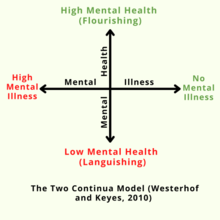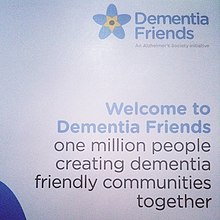Mental health
According to the World Health Organization (WHO), it is a "state of well-being in which the individual realizes his or her abilities, can cope with the normal stresses of life, can work productively and fruitfully, and can contribute to his or her community".[14][15] Psychiatrists, psychologists, licensed professional clinical counselors, social workers, nurse practitioners, and family physicians can help manage mental illness with treatments such as therapy, counseling, and medication.[17][18] Isaac Ray, the fourth president[19] of the American Psychiatric Association and one of its founders, further defined mental hygiene as "the art of preserving the mind against all incidents and influences calculated to deteriorate its qualities, impair its energies, or derange its movements".[26][27] In the post-WWII years, references to mental hygiene were gradually replaced by the term 'mental health' due to its positive aspect that evolves from the treatment of illness to preventive and promotive areas of healthcare.The closure of state-provisioned psychiatric hospitals was enforced by the Community Mental Health Centers Act in 1963 that laid out terms in which only patients who posed an imminent danger to others or themselves could be admitted into state facilities.[20] In this source, researchers analyze how most compensation prisoners (detainees who are unable or unwilling to pay a fine for petty crimes) are unemployed, homeless, and with an extraordinarily high degree of mental illnesses and substance use disorders.[31] Compensation prisoners then lose prospective job opportunities, face social marginalization, and lack access to resocialization programs, which ultimately facilitate reoffending.Families of patients, advocates, and mental health professionals still call for increase in more well-structured community facilities and treatment programs with a higher quality of long-term inpatient resources and care.[37] Evidence from the WHO suggests that nearly half of the world's population is affected by mental illness with an impact on their self-esteem, relationships and ability to function in everyday life.[42] Many therapeutic systems and self-help books offer methods and philosophies espousing strategies and techniques vaunted as effective for further improving the mental wellness.More than half of mental health conditions start before a child reaches 20 years of age, with onset occurring in adolescence much more frequently than it does in early childhood or adulthood.Education in spiritual and religious matters is also required by the American Psychiatric Association,[75] however, far less attention is paid to the damage that more rigid, fundamentalist faiths commonly practiced in the United States can cause.They are employed in both outpatient and inpatient settings of a hospital, nursing homes, state and local governments, substance use clinics, correctional facilities, health care services, private practice, etc.[84] Gender, age, ethnicity, life expectancy, longevity, population density, and community diversity are all demographic characteristics that can increase the risk and severity of mental disorders.Countries were classified with World Bank criteria as low-income (Nigeria), lower-middle-income (China, Colombia, South Africa, Ukraine), higher middle-income (Lebanon, Mexico), and high-income.The results find that people who thrive with financial stability or fall under low socioeconomic status (SES) tend to perform worse cognitively due to external pressure imposed upon them.The research found that stressors such as low income, inadequate health care, discrimination, and exposure to criminal activities all contribute to mental disorders.[108] For a child to grow up emotionally healthy, the children under three need "A strong, reliable primary caregiver who provides consistent and unconditional love, guidance, and support.This process, known as attunement, is most crucial during the first 6–24 months of infants' lives and helps them develop a wider range of healthy emotions, including gratitude, forgiveness, and empathy."Prevention emphasizes the avoidance of risk factors; promotion aims to enhance an individual's ability to achieve a positive sense of self-esteem, mastery, well-being, and social inclusion.Patients' also reported feelings of greater validation, engagement, remembering their care plan, and acquiring a better awareness of potential side effects of their medications, when reading their mental health notes.[142] Researchers continue to find effective ways to use social media to bring more awareness to mental health issues through online campaigns in other sites such as Facebook and Instagram.Care navigators work closely with patients and families through discussion and collaboration to provide information on best therapies as well as referrals to practitioners and facilities specializing in particular forms of emotional improvement.[155] A meta-analysis was done by Alexendru Boncu, Iuliana Costeau, & Mihaela Minulescu (2017) looking at social-emotional learning (SEL) studies and the effects on emotional and behavior outcomes.[170] In 1843, Dorothea Dix submitted a Memorial to the Legislature of Massachusetts, describing the abusive treatment and horrible conditions received by the mentally ill patients in jails, cages, and almshouses.She revealed in her Memorial: "I proceed, gentlemen, briefly to call your attention to the present state of insane persons confined within this Commonwealth, in cages, closets, cellars, stalls, pens!Chained, naked, beaten with rods, and lashed into obedience...."[171] Many asylums were built in that period, with high fences or walls separating the patients from other community members and strict rules regarding the entrance and exit.World War I catalyzed this idea with an additional emphasis on the impact of maladjustment, which convinced the hygienists that prevention was the only practical approach to handle mental health issues.By 1977, 650 community mental health centers were built to cover 43 percent of the population and serve 1.9 million individuals a year, and the lengths of treatment decreased from 6 months to only 23 days.The program stressed the importance of other supports in addition to medical care, including housing, living expenses, employment, transportation, and education; and set up new national priority for people with serious mental disorders.





Mental health lawMental disorderPsychiatryClinical psychologyMedicinePsychologyAbortionAnti-psychiatryBrain health and pollutionClimate changeControversies about psychiatryDigital mediaHomelessnessImmigration detentionMental illness denialMental health of refugeesMental health of veteransHistory of mental disordersHistory of mental healthcareHistory of psychotherapyAustraliaPalestineRussiaSouth KoreaUnited KingdomUnited StatesAfrican AmericansAsian AmericansFilipino AmericansNative AmericansHealthPublic healthOutlineCommunity healthDental public healthEnvironmental healthEpidemiologyHealth economicsHealth educationHealth promotionHealth policyHealth politicsOccupational safetyRehabilitation (penology)Sexual and reproductive healthSanitationGlobal healthInternational healthDisease surveillanceBehavior changeHealth indicatorsNational public health agenciesemotionalpsychologicalsocialwell-beingcognitionperceptionbehaviorWorld Health Organization (WHO)stressesstressinterpersonal relationshipsdecision-makingself-efficacyautonomyself-actualizationintellectualpositive psychologyholismabilitypsychological resilienceCultural differencessleep irritationlack of energylack of appetiteharming oneselfintroversionPublic Health Agency of Canadaquality of lifemental disordersanxietydepressionICD-11diagnoseclassification system of mental disordersmedicationEudaimoniaHygieneIsaac RayAmerican Psychiatric AssociationDorothea Dixhuman rightsEmil KraepelintaxonomyClifford Beerslunatic asylumsclinicsocial hygiene movementeugenicssterilizationdeinstitutionalizationcommunity mental health servicesvaccinationstransinstitutionalizationsubstance use disordersPrevalence of mental disordersMental illnessescancerdiabetesheart diseaseMajor depressiondiseasesuicideWorld Health Organizationself-esteemalcohol use disordervandalismsocial stigmaGlobal mental healthcontinuumvaluesMental wellnessemotional well-beingcreativeholistic